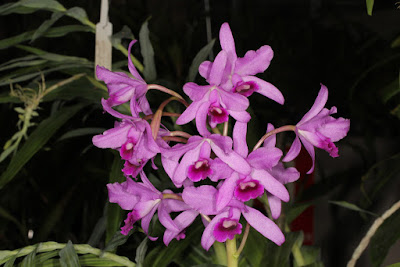Guarianthe bowringiana is native to Guatemala and Belize. These plants grow on rocky cliffs and on the slopes of ravines near high-speed streams where the air is saturated with moisture...
Guarianthe bowringiana also called as Bowring's Guarianthe, Cattleya bowringiana, Cattleya skinneri var. bowringiana, Cattleya autumnalis, is a species of the genus Guarianthe. This species was described by Robert Louis Dressler & W. E. Higgins in 2003.
IDENTIFY GUARIANTHE BOWRINGIANA
Guarianthe bowringiana is native to Guatemala and Belize. These plants grow on rocky cliffs and on the slopes of ravines near high-speed streams where the air is saturated with moisture. In general, they are found on granite and limestone rock formations, at heights of 100-1000 m, but sometimes they are found growing on trees in mixed, pine-oak forests.
It is a medium to large sized, hot to warm growing lithophyte, which reaching 20-35 cm, and sometimes even 61-91 cm in length, with club-shaped, 20-91 cm long pseudobulbs carrying 2, rarely 3, apical, narrowly oblong, leathery, dark green, 15-20 cm long and about 5 cm wide leaves.
Bowring's Guarianthe blooms in the fall on a terminal, erect or nodding, long-stalked, to 25 cm long, few to many flowered inflorescence arising through 2, basal, compressed spathes carrying up to 15 flowers that are not long lasting. The flowers usually have less than 7 cm in diameter. They have wide flakes of external whorl and even wider flakes of inner whorl with wavy edges. The whole lip is rolled up, creating an open tube, but the undulated edges do not reach each other above the rod. The front lip of the lip is also wavy. The petals of both whorls are pinkish-purple and sometimes have darker veins. They often have a nicely shimmering surface, especially when viewed in good light. The outside of the lip is darker purple with a dark-brown band between the outer lip of the lip and the throat. The throat is white with a pale yellow edge.
GUARIANTHE BOWRINGIANA CARE AND CULTURE
Cultural information should only be used as a guide, and should be to be adapted to suit you. Your physical location; where you grow your plants, how much time you have to devote to their care, and many other factors, will need to be taken into account. Only then can you decide on the cultural methods that best suit you and your plants.
Light:
Guarianthe bowringiana needs a light level of 30000-35000 lux. These plants grow best at high levels of light and strong air movement.
Temperature:
The average temperature of the summer day is 29-30 ° C, the night 19-20 ° C, and the daily difference is 10 ° C. In spring before the beginning of the rainy season, the average temperature of the day is 29-32 ° C, the night 17-19 ° C, and the daily difference is 11-12 ° C. The average temperature of the winter day is 24-26 ° C, the night 15-16 ° C, and the daily difference 9-11 ° C.
Humidity:
Bowring's Guarianthe the average humidity of probably 80% throughout the year. For good growth, these plants need high humidity.
Substrate, growing media and repotting:
Guarianthe bowringiana are usually grown in pots with a very loose, quickly drying ground because they need frequent watering, but the roots can not stay wet.
Repotting or dividing should only be done when new roots begin to grow. This allows plants to stabilize as quickly as possible in a new substrate.
Watering:
Precipitation is moderate to moderate for most of the year, but it is smaller in the 4-5 winter months. During active growth, the plants should be watered frequently, but the roots must dry out between waterings. When new growths reach maturity in autumn, the amount of water should be gradually reduced.
Fertilizer:
Weekly use of 1/4-1/2 of the recommended dose of orchid fertilizer is recommended. A balanced or high nitrogen fertilizer is beneficial from spring to mid-summer, but then until the end of autumn, high phosphorus fertilizer should be used.
Rest period:
In winter, the amount of water should be reduced, especially if the Guarianthe bowringiana are grown in the conditions of a short, dark day, but the plants can never remain without water for too long. Fertilization should be reduced or eliminated until spring. The plants grown in greenhouses should be set close to the windows so that they receive as much light as possible, so that the leaves do not get burned.















It is so interesting to read your post. I have a couple of quite old Cattleya Bowringiana orchids, the flower of which looks like yours. Some of my labels have become a little mixed up and I was pleased to see your Bowringiana flower to confirm identification. You mention though that there is a pale yellow edge around the white throat which most of mine don't have but I think one pot does. I can't see the yellow edge on your flower either. Is it very faint? Anyway it's a beautiful orchid.Thaks for sharing, Pauline.
ReplyDelete